Gaming products and services provider Light & Wonder (NASDAQ:LNW) beat analysts' expectations in Q1 CY2024, with revenue up 12.8% year on year to $756 million. It made a GAAP profit of $0.88 per share, improving from its profit of $0.24 per share in the same quarter last year.
Light & Wonder (LNW) Q1 CY2024 Highlights:
- Revenue: $756 million vs analyst estimates of $717.4 million (5.4% beat)
- EPS: $0.88 vs analyst estimates of $0.65 (34.7% beat)
- Gross Margin (GAAP): 71%, down from 83.9% in the same quarter last year
- Free Cash Flow of $93 million, down 13.1% from the previous quarter
- Market Capitalization: $8.82 billion
With names as crazy as Ultimate Fire Link Power 4 for its products, Light & Wonder (NASDAQ:LNW) is a gaming company supplying the casino industry with slot machines, table games, and digital games.
The company is known for its immersive slot machines with massive LED screens and vibrant colors. Combined with its other offerings, including mobile games developed by SciPlay (a company it acquired in 2023), Light & Wonder caters to both the physical and online gaming markets (iGaming).
Light & Wonder generates revenue through the one-off sales and leasing of gaming hardware to casinos, lottery services, and fees associated with its mobile gaming solutions. Its leased hardware products have a particularly unique business model, where it has revenue share agreements with casinos based on how much money a machine wins per day.
Generally, casino customers are free to place their leased machines wherever they'd like on the casino floor and can remove them if they underperform, meaning Light & Wonder would generate no revenue from its revenue share agreement. To mitigate this risk, the company will occasionally pay placement fees to casinos to guarantee a spot on the floor for a designated period, typically a few years.
Gaming Solutions
Gaming solution companies operate in a dynamic and evolving market, and the digital transformation of the gaming industry presents significant opportunities for innovation and growth, whether it be immersive slot machine terminals or mobile sports betting. However, the gaming solution industry is not without its challenges. Regulatory compliance is a crucial consideration as companies must navigate a complex and often fragmented regulatory landscape across different jurisdictions. Changes in regulations can impact product offerings, operational practices, and market access, requiring companies to maintain flexibility and adaptability in their business strategies. Additionally, the competitive nature of the industry necessitates continuous investment in research and development to stay ahead of competitors and meet evolving consumer demands.
Sales Growth
A company's long-term performance can indicate its business quality. Any business can enjoy short-lived success, but best-in-class ones sustain growth over many years. Light & Wonder's revenue declined over the last five years, dropping 2.5% annually. 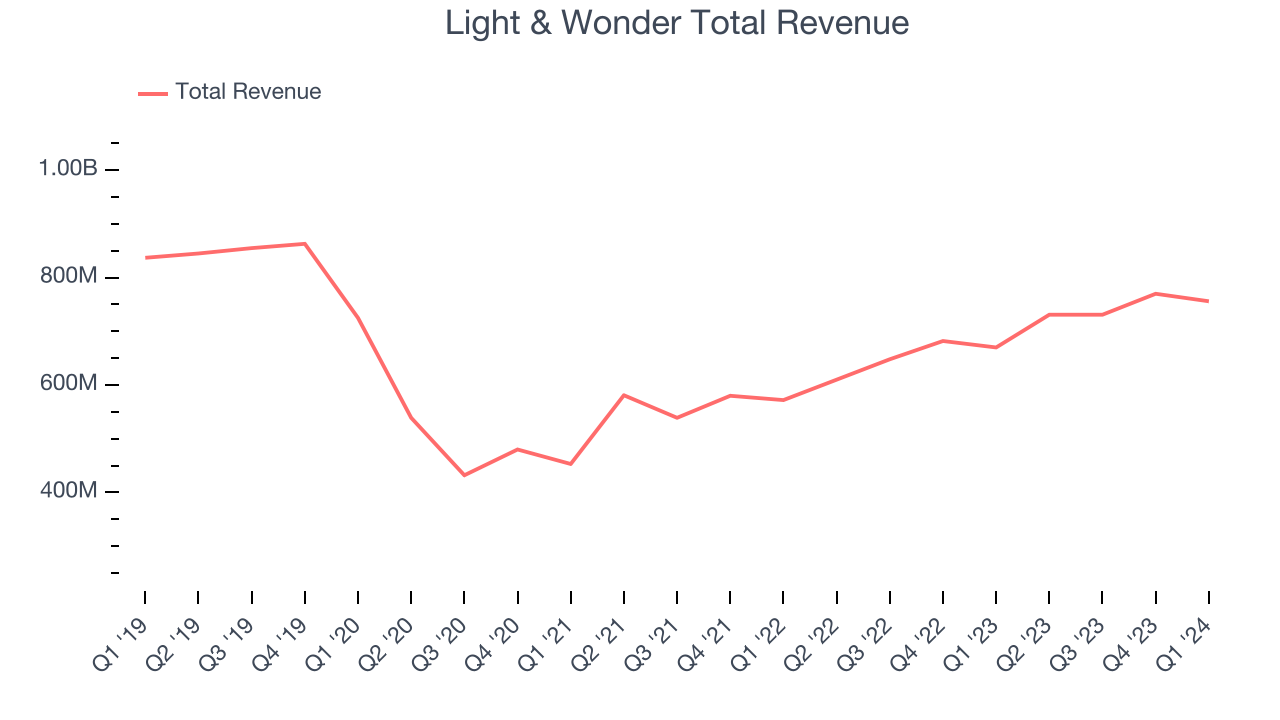 Within consumer discretionary, product cycles are short and revenue can be hit-driven due to rapidly changing trends. That's why we also follow short-term performance. Light & Wonder's annualized revenue growth of 14.7% over the last two years is a reversal from its five-year trend, suggesting some bright spots.
Within consumer discretionary, product cycles are short and revenue can be hit-driven due to rapidly changing trends. That's why we also follow short-term performance. Light & Wonder's annualized revenue growth of 14.7% over the last two years is a reversal from its five-year trend, suggesting some bright spots.
We can better understand the company's revenue dynamics by analyzing its three most important segments: Gaming, Social Gaming, and iGaming, which are 63%, 27.2%, and 9.8% of revenue. Over the last two years, Light & Wonder's revenues in all three segments increased.Gaming revenue (slot machines, casino games) averaged year-on-year growth of 15.5% while Social Gaming (digital games) and iGaming (free-to-play games) averaged 14% and 12.3%.
This quarter, Light & Wonder reported robust year-on-year revenue growth of 12.8%, and its $756 million of revenue exceeded Wall Street's estimates by 5.4%. Looking ahead, Wall Street expects sales to grow 7.2% over the next 12 months, a deceleration from this quarter.
Operating Margin
Operating margin is a key measure of profitability. Think of it as net income–the bottom line–excluding the impact of taxes and interest on debt, which are less connected to business fundamentals.
Light & Wonder has been a well-managed company over the last eight quarters. It's demonstrated it can be one of the more profitable businesses in the consumer discretionary sector, boasting an average operating margin of 16.4%.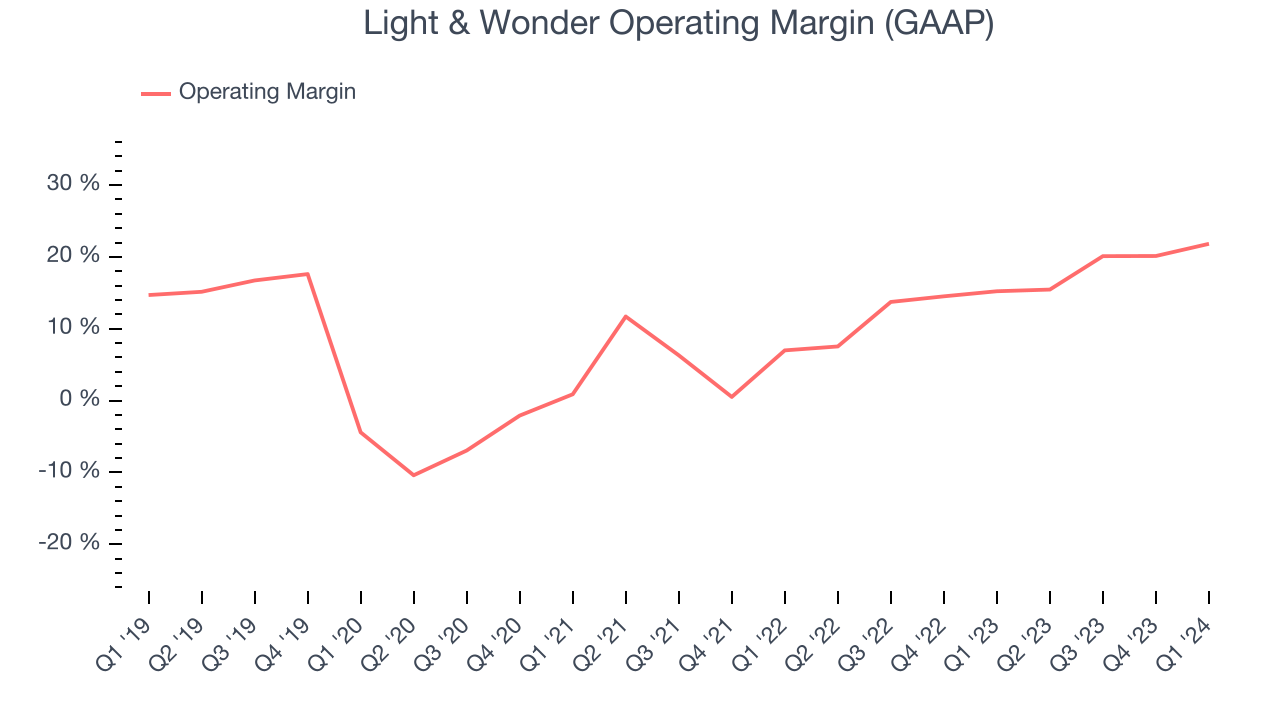
In Q1, Light & Wonder generated an operating profit margin of 21.8%, up 6.6 percentage points year on year.
Over the next 12 months, Wall Street expects Light & Wonder to become more profitable. Analysts are expecting the company’s LTM operating margin of 19.4% to rise to 24.3%.EPS
We track long-term historical earnings per share (EPS) growth for the same reason as long-term revenue growth. Compared to revenue, however, EPS highlights whether a company's growth was profitable. 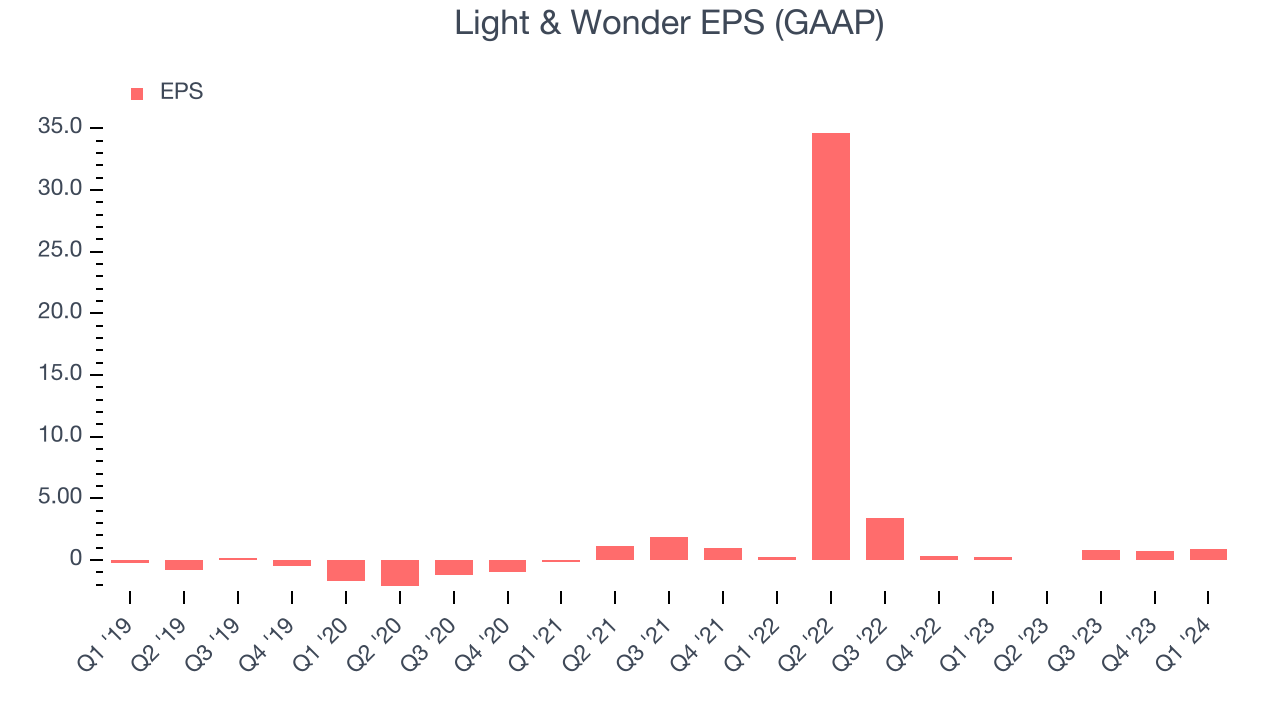
Over the last five years, Light & Wonder cut its earnings losses and improved its EPS by 26.4% each year. This performance is materially higher than its 2.5% annualized revenue declines over the same period. Let's dig into why.
Light & Wonder's operating margin has expanded 7.1 percentage points over the last five years, leading to higher profitability and earnings. Taxes and interest expenses can also affect EPS growth, but they don't tell us as much about a company's fundamentals.In Q1, Light & Wonder reported EPS at $0.88, up from $0.24 in the same quarter last year. This print beat analysts' estimates by 34.7%. Over the next 12 months, Wall Street expects Light & Wonder to grow its earnings. Analysts are projecting its LTM EPS of $2.40 to climb by 70.7% to $4.10.
Cash Is King
If you've followed StockStory for a while, you know we emphasize free cash flow. Why, you ask? We believe that in the end, cash is king, and you can't use accounting profits to pay the bills.
While Light & Wonder posted positive free cash flow this quarter, the broader story hasn't been so clean. Over the last two years, Light & Wonder's demanding reinvestments to stay relevant with consumers have drained company resources. Its free cash flow margin has been among the worst in the consumer discretionary sector, averaging negative 3.7%.
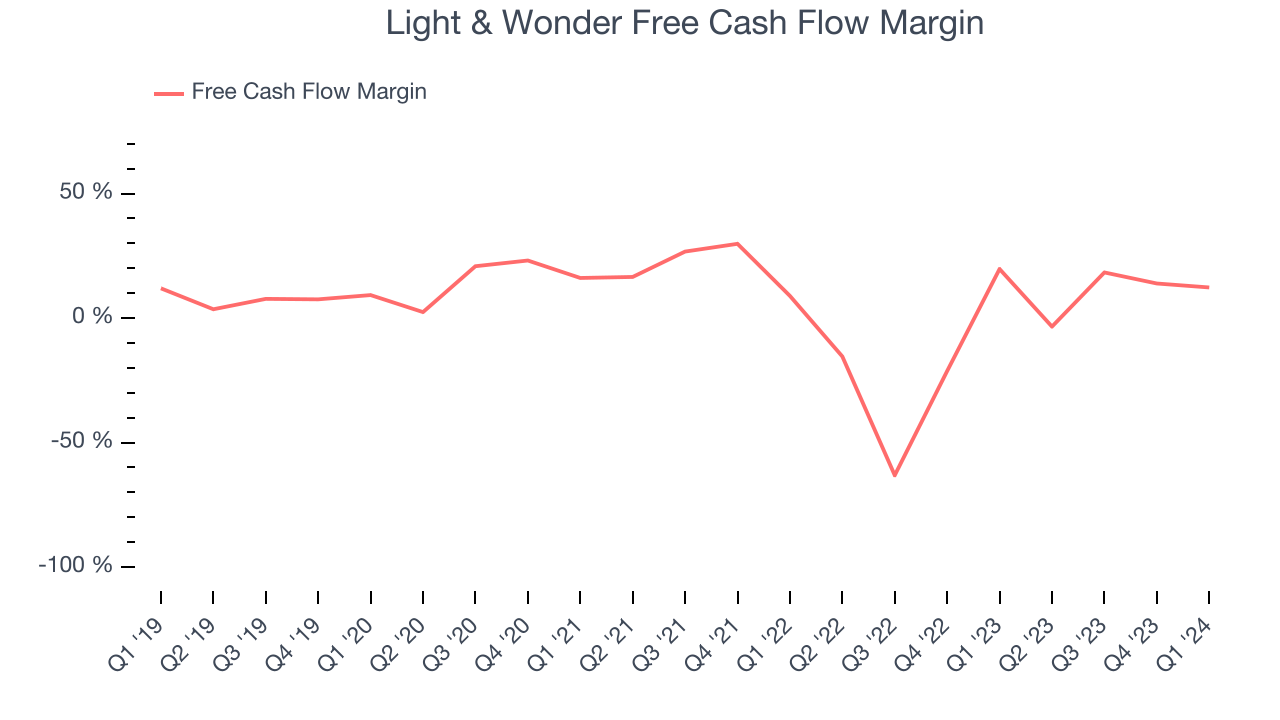
Light & Wonder's free cash flow came in at $93 million in Q1, equivalent to a 12.3% margin and down 29.5% year on year.
Return on Invested Capital (ROIC)
EPS and free cash flow tell us whether a company was profitable while growing revenue. But was it capital-efficient? Enter ROIC, a metric showing how much operating profit a company generates relative to how much money the business raised (debt and equity).
Light & Wonder's five-year average return on invested capital was 6.8%, somewhat low compared to the best consumer discretionary companies that pump out 25%+. Its returns suggest it historically did a subpar job investing in profitable business initiatives.
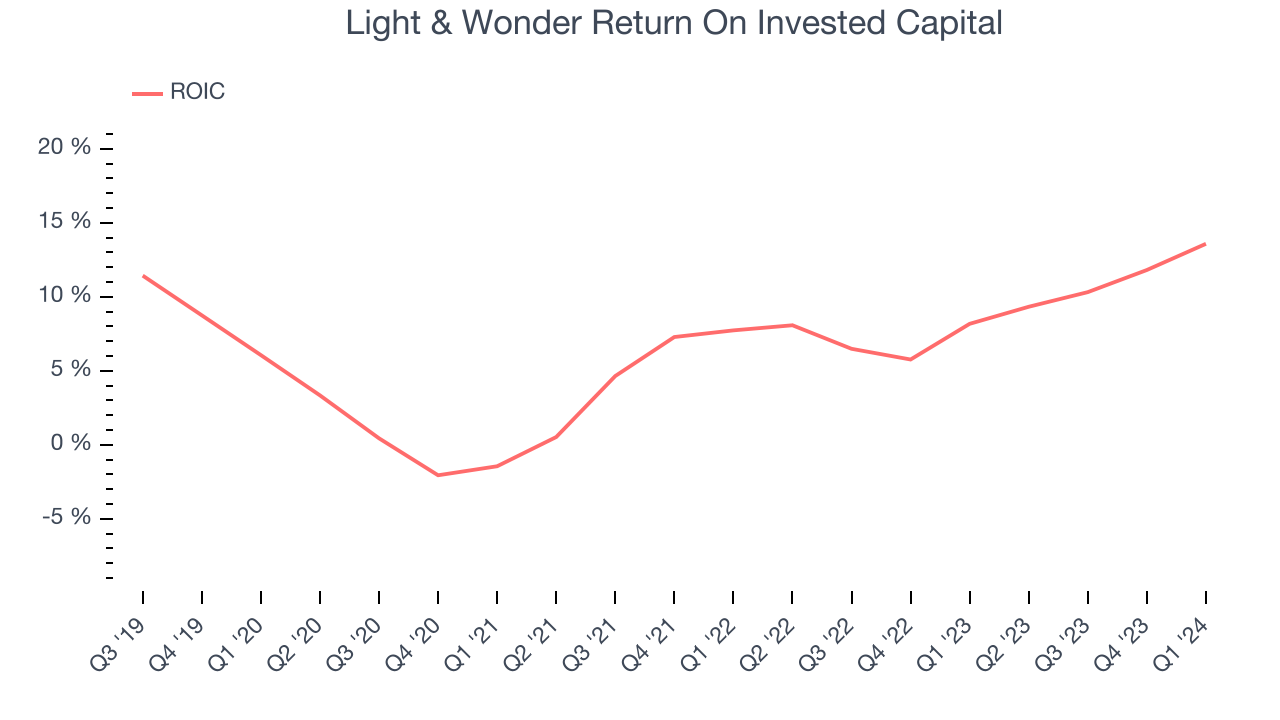
The trend in its ROIC, however, is often what surprises the market and drives the stock price. Over the last few years, Light & Wonder's ROIC averaged 8.6 percentage point increases. This is a good sign, and we hope the company can continue improving.
Balance Sheet Risk
As long-term investors, the risk we care most about is the permanent loss of capital. This can happen when a company goes bankrupt or raises money from a disadvantaged position and is separate from short-term stock price volatility, which we are much less bothered by.
Light & Wonder reported $450 million of cash and $3.91 billion of debt on its balance sheet in the most recent quarter. As investors in high-quality companies, we primarily focus on two things: 1) that a company's debt level isn't too high and 2) that its interest payments are not excessively burdening the business.
With $1.15 billion of EBITDA over the last 12 months, we view Light & Wonder's 3.0x net-debt-to-EBITDA ratio as safe. We also see its $293 million of annual interest expenses as appropriate. The company's profits give it plenty of breathing room, allowing it to continue investing in new initiatives.
Key Takeaways from Light & Wonder's Q1 Results
We were impressed by how significantly Light & Wonder blew past analysts' EPS expectations this quarter. We were also excited its operating margin outperformed Wall Street's estimates. On the other hand, its gross margin was 71%, down from 83.9% in the same quarter last year. The stock is flat after reporting and currently trades at $96.52 per share.
Is Now The Time?
Light & Wonder may have had a good quarter, but investors should also consider its valuation and business qualities when assessing the investment opportunity.
We cheer for all companies serving consumers, but in the case of Light & Wonder, we'll be cheering from the sidelines. Its revenue has declined over the last five years, but at least growth is expected to increase in the short term. And while its projected EPS for the next year implies the company's fundamentals will improve, the downside is its cash burn raises the question of whether it can sustainably maintain growth. On top of that, its relatively low ROIC suggests it has historically struggled to find compelling business opportunities.
Light & Wonder's price-to-earnings ratio based on the next 12 months is 22.2x. While there are some things to like about Light & Wonder and its valuation is reasonable, we think there are better opportunities elsewhere in the market right now.
Wall Street analysts covering the company had a one-year price target of $109.91 per share right before these results (compared to the current share price of $96.52).
To get the best start with StockStory, check out our most recent stock picks, and then sign up for our earnings alerts by adding companies to your watchlist here. We typically have the quarterly earnings results analyzed within seconds of the data being released, and especially for companies reporting pre-market, this often gives investors the chance to react to the results before the market has fully absorbed the information.
